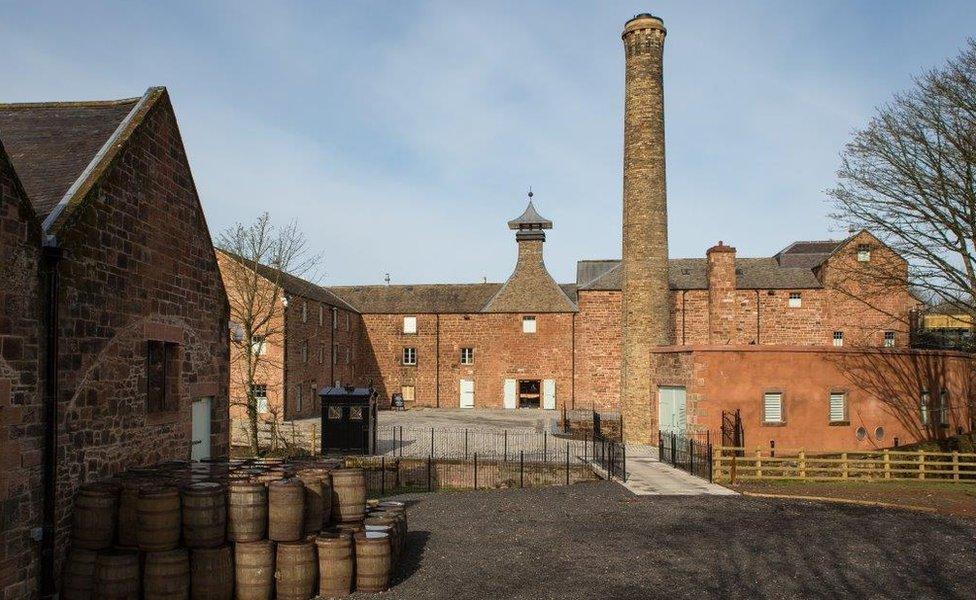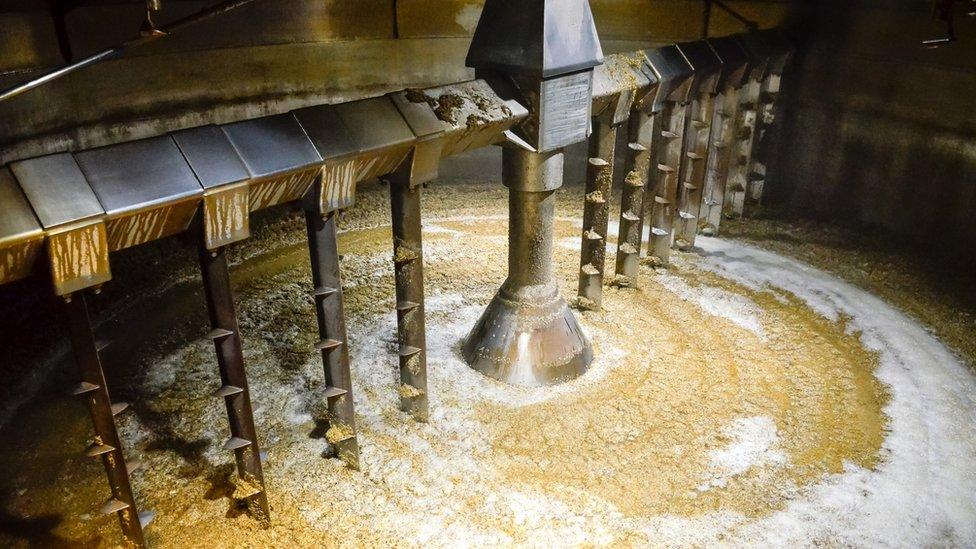Whisky pours into Dumfries and Galloway and the Borders
- Published

It started out as a trickle, but now the plans have the glug-glug-glug of a much more steady flow.
Two regions of Scotland where the whisky production glass was empty now have the makings of a decent dram.
And their distillery plans could bring the warm glow of greater economic prosperity to Dumfries and Galloway and the Scottish Borders.
At least, that is what the people behind them - and local residents - are hoping.
Leading the way has been the Annandale Distillery, near Annan, officially opened by the Princess Royal earlier this year but with its first cask actually filled late in 2014.
A multi-million pound renovation project saw it return to production after being closed for more than 90 years.
What the owners described as the area's "most ambitious tourism story" had a goal of 50,000 visitors a year.

The Annandale Distillery was officially opened by the Princess Royal earlier this year
It is a transformation which it is hoped can be repeated elsewhere in southern Scotland.
Further west, at Bladnoch near Wigtown, Australian entrepreneur David Prior has ambitious plans for another site which had ceased production.
It is only six years, however, since the whisky flowed at Scotland's most southerly distillery - a facility which dates back nearly two centuries.
Mr Prior outlined earlier this week how he hoped to make it a "cornerstone of the community".
Campbell Evans, an industry consultant working with Bladnoch, said the rise of Scotch whisky sales around the world in the last decade was fuelling expansion across the country - including previously barren areas.
"The recent lack of operating distilleries in the south of Scotland provides an opportunity to re-establish the Lowland reputation as part of wider industry growth," he said.
"Traditionally Lowland whiskies are like the countryside of their making, light, soft and mellow by comparison with whiskies made elsewhere in Scotland."
It takes time, however, for these investments to pay off.

A new owner has recently taken over Bladnoch Distillery near Wigtown
"Scotch whisky is a long term business," said Mr Evans. "By law the spirit must mature for at least three years before it can be called Scotch whisky.
"Most malt whisky is sold after eight, 10 or more years maturation.
"New distillers therefore require patience and capital to distil and carry maturing stocks for many years before the whisky can be sold. Some distilleries will make white spirits such as gin and vodka to aid cash flow."
He said that at Bladnoch there were existing stocks lying in the warehouse which would be available for bottling in due course.
Over in the Borders, they are looking to start their facilities from scratch.
Last year, Mossburn Distillers unveiled plans for a £40m new distillery south of Jedburgh.
It was hoped the scheme could create 50 full-time jobs with more than seven million bottles a year produced at the site.

And this year a novel competition was launched by R&B Distillers to allow the public to select the location for the region's first distillery since 1837.
Peebles currently leads the way in that vote.
One of the men behind the plans, Alasdair Day, firmly believes there is a boom of small distilleries under way - citing as evidence the large number of new Scottish gins being produced.
"The interest in this new Scottish gin has been driven by provenance, the location, the individual 'botanicals' used and the fact that these are 'local', small and not mass produced," he said.
"I believe that this will also drive the interest in Scotch whisky over the next five years as it starts to come on to the market.
"There is no doubt that all of these distillery projects will have a positive influence on the local economy both directly through employment, indirectly by bringing visitors to the region and income for other local businesses."

The investment in a whisky distillery is described as a "long-term" one
He added that it could be "beneficial for visitors and local businesses alike" if a south of Scotland whisky trail was created in due course.
The Scotch Whisky Association said "international demand and aspirational consumers" were driving distillery growth across Scotland.
Head of communications Rosemary Gallagher said the area had a strong history to build on.
"The south of Scotland was, in the past, well-known for Scotch whisky production and it is good to see it return," she said.
"But distilling in the lowlands of Scotland is not a new phenomenon - Auchentoshan and Glenkinchie, for example, have been distilling for many years producing single malt Scotch whisky exported across the globe."
'Future optimism'
She added that the industry's future looked bright and that could only benefit the Borders and Dumfries and Galloway.
"We are seeing further investment in the Scotch whisky industry across the country, including the south of Scotland, so there is clearly optimism about the future," she said.
"Despite a small decline in Scotch whisky exports recently, due to economic headwinds and political factors in some markets, they are still worth about £4bn annually.
"We expect new markets to open up, mature ones to grow and demand to increase."
And the south of Scotland is now in a much stronger position to take advantage of that growth than it was just a few years ago.